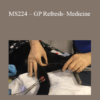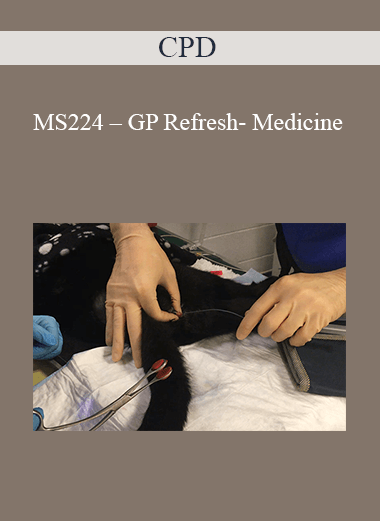$479.00 Original price was: $479.00.$114.00Current price is: $114.00.
 Purchase this course you will earn 114 Points worth of $11.40
Purchase this course you will earn 114 Points worth of $11.40Elevate your skills with the CPD – MS224 – GP Refresh- Medicine course, available for just $479.00 Original price was: $479.00.$114.00Current price is: $114.00. on Utralist.com! Browse our curated selection of over 60,000 downloadable digital courses across diverse Everything Else. Benefit from expert-led, self-paced instruction and save over 80%. Start learning smarter today!
Purchase CPD – MS224 – GP Refresh- Medicine courses at here with PRICE $479 $114
MS224 – GP Refresh- Medicine
£347.00 (+VAT)
12 months access to recordings and course materials is included. Please note that these are webinar recordings and not live events. Full details on how to access the Mini Series will be emailed to you.
- Join Amanda Paul BSc(Hons) BVSc(Hons) MVetSt MVIM MANZCVSc IVAS (Cert) MRCVS DipECVIM-CA for three 2-hour online sessions
- Comprehensive notes to downloaded
- Self-assessment quizzes to ‘release’ your 8 hours CPD certification (don’t worry, you can take them more than once if you don’t quite hit the mark first time)
- A whole year’s access to recorded sessions for reviewing key points (and in case you miss a live session!)
- Superb value for money – learn without travelling
- Watch the recordings on your iPad!
- This Mini Series was originally broadcast in March 2020
Programme
Immune mediated disease – Haemolytic anaemia and thrombocytopenia
Immune–mediated thrombocytopenia (ITP) and haemolytic anaemia (IMHA) are common autoimmune diseases of the haematologic system in dogs. In cats IMHA is somewhat less common but not infrequent and feline primary ITP is a rare condition with only a few cases described in the literature. The diagnosis of IMHA is suspected when a haemogram reveals spherocytosis and a regenerative anaemia which is usually accompanied by a positive Coombs test and saline agglutination test in dogs. This is not always the case in cats and the diagnosis can be more challenging. Diagnosis of ITP is typically one of exclusion, and there is an increased risk of spontaneous haemorrhage with platelet concentrations 30,000 cells/µL. Treatment of these autoimmune diseases requires vigorous immunosuppressive therapy, of which there are a number of therapies available that are used with variable results and various side effects. There can be a both complications both with therapy and secondary diseases and management can be more complicated than treatment of the primary immune mediated disease alone.
What you’ll learn:
- The approach and diagnosis of IMHA and ITP
- Reading a blood report and blood smear
- What ancillary tests and investigation is recommended
- Treatment and management of IMHA and ITP
- Why and what to do when things go wrong or aren’t as you expect them to be
The Lower urinary tract- Obstructive disease in the dog and cat
Obstructive lower urinary tract disease can be a result of physical or functional obstruction. Obstruction with uroliths remains one of the most challenging tasks facing the veterinary practitioner in both dogs and cats. Recurrence of uroliths is frustrating and often blamed on failure of medical treatment to prevent repeat urolith formation assuming all uroliths were removed prior to therapeutic intervention. The most common case of rapidly recurrent uroliths is incomplete removal. Diagnosis of functional obstruction such as urethral dyssynergia and lower urinary tract syndrome (LUTS) is based on the exclusion of detectable pathological conditions which could also cause urine outflow obstruction. In some cats, because of a combination of genetics and early environment, have a more sensitive and overactive sympathetic nervous system, which may be associated with abnormalities in intestinal, behavioural, dermatologic, epithelial, neurologic, endocrine, or immune systems which is a consideration in disease management.
What you’ll learn:
- Physical and functional obstruction in cats and dogs
- Uroliths and their management and prevention
- Current concepts and management of FLUTD
- Techniques to relieve physical and functional obstruction in practice
- Management of reflex dyssynergia in dogs
The Liver- Testing and diagnosis of hepatic disease in the dog and cat
The presence of liver disease is often first recognized on the basis of raised liver enzymes. This can be challenging to interpret and understand, as increased liver enzyme activity is more common than the actual prevalence of liver disease. Interpretation of liver enzymes must be interpreted with respect to the medical history, physical examination findings, routine laboratory test results, specific assessments of liver function, and imaging studies and histopathology. Recognising whether enzyme abnormalities are persistent or cyclic helps to categorize different hepatobiliary disorders. There are also several clinical syndromes can develop in many different liver diseases. They are important to understand the clinical manifestations of hepatobiliary diseases.
What you’ll learn:
- Biochemical interpretation with hepatic disease
- Functional testing of the liver
- Various diagnosis of hepatobiliary disease in dogs and cats
- Clinical syndromes associated with hepatobiliary disease
- Management of disease and clinical syndromes
Purchase CPD – MS224 – GP Refresh- Medicine courses at here with PRICE $479 $114
Cultivate continuous growth with the CPD – MS224 – GP Refresh- Medicine course at Utralist.com! Unlock lifetime access to premium digital content, meticulously designed for both career advancement and personal enrichment.
- Lifetime Access: Enjoy limitless access to your purchased courses.
- Exceptional Value: Benefit from savings up to 80% on high-quality courses.
- Secure Transactions: Your payments are always safe and protected.
- Practical Application: Gain real-world skills applicable to your goals.
- Instant Accessibility: Begin your learning journey immediately after buying.
- Device Compatible: Access your courses seamlessly on any device.
Transform your potential with Utralist.com!
Related products
Everything Else
= 52 Points
Everything Else
= 56 Points
Everything Else
= 38 Points
Everything Else
= 40 Points
= 89 Points
Everything Else
Jacob Sokol – Quadruple Your Coaching Biz 19 expert sessions
= 43 Points
Everything Else
= 38 Points
Everything Else
= 56 Points
Login

 Purchase this course you will earn 114 Points worth of $11.40
Purchase this course you will earn 114 Points worth of $11.40










